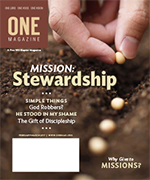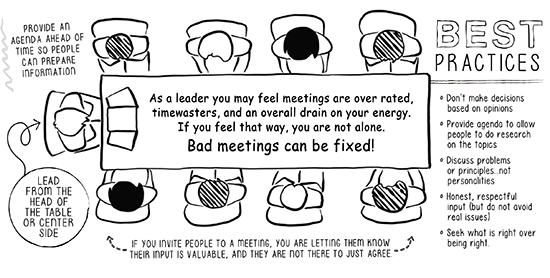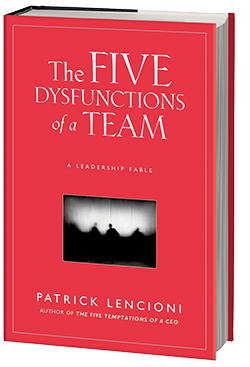
February-
March 2017
Mission: Stewardship
------------------
|






The column "Leadership Whiteboard" provides a short visual leadership coaching moment. It introduces and explains a new sketch in each issue, provides leadership coaching for further development, and shares a leadership quote and recommended book.
How to Lead a Meeting
To be very clear, this white-board topic is not about meetings where information or details are shared about some event. If you simply wish to inform people, send them an email and don’t waste their time. But if you want to gather and inspire people toward significant goals, then allow input and collaboration. The result gives the group ownership to passionately help the idea succeed and shape the direction. When leaders understand why people meet, the fundamentals of the meeting change from leader directed information to a think-tank environment.
If collaborative meetings help groups decide on activities, strategy, and higher-level decisions, then what should you change about how meetings are conducted? Leaders should provide an agenda of discussion items ahead of time to help people think through the problem for possible solutions, research costs, best-practices of others, and consider alternatives. If the attendees know your goals ahead of time, then the group might come up with numerous ways to accomplish them.

A goal is not the method for accomplishing an end result—it is the end result with many avenues to get there. Leaders cast vision for goals but followers help you discuss how to get there because the followers are typically the ones to do the leg-work and would like to share input. After the collaboration, the leader still makes the final call.
This type of collaboration requires a comfortable leader willing to listen to the people around him or her. There is a very important phrase we use at Randall House often—seek what is right over being right. Always trying to win the argument loses the followers and their desire to help it succeed.
Create an environment that allows healthy disagreeable discussion, so that you teach the group to be critical of ideas rather than people. Not agreeing with an idea is not the same as disparaging the person who brought the idea. The quality of input from people in the room is directly tied to their perception of whether the honest feedback is accepted. Never be afraid to have disagreements in meetings, it is the foundation of trust to which great accomplishments can be attained.

Recommended Book
Leadership Quote
"When there is trust, conflict becomes nothing but the pursuit of truth, an attempt to find the best possible answer." —Patrick Lencioni
About the Columnist: Ron Hunter Jr. has served as the director of Randall House Publications for 14 years, and has led the organization into family ministry initiatives for the past 12 years. |
|

